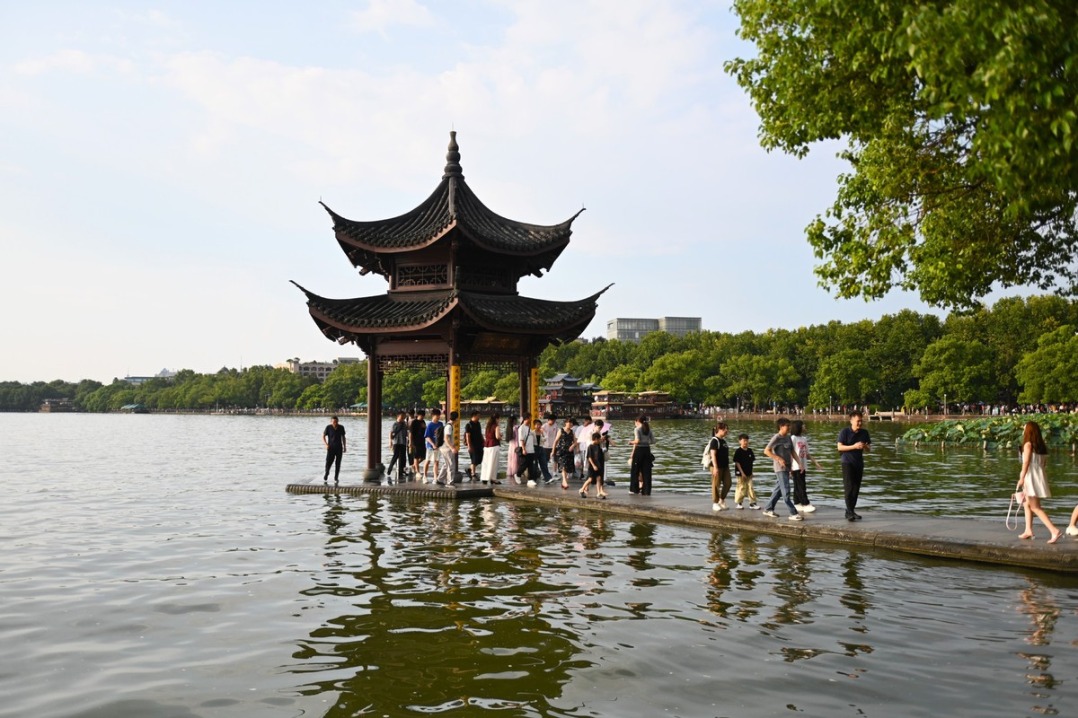Ancient cities mark 35th year as twins

While Nanjing, China and Florence, Italy are very far apart, they both are beautiful and historic tourism locales
They are both steeped in natural beauty, history and the trappings of royalty. Both have acted as economic powerhouses and as capital cities. And soon the pair will celebrate the 35th anniversary of a sister-city relationship that is rooted in their shared experience of past glories.
Welcome to Nanjing and welcome to Florence.
| People walk on the Ponte Vecchio, or Old Bridge, a Medieval stone bridge over the Arno River in Florence. Photos by Du Xiaoying / China Daily |
Nanjing, in East China's Jiangsu province, is the elder of the two sisters. A fort named Yecheng, in the area of what is Nanjing today, was founded by Fuchai, king of the State of Wu in 495 BC, and Florence in Italy was founded 436 years later, in 59 BC, by Julius Caesar.
But if the Chinese city can lord it over its relatively young sister with its age, Florence, in Tuscany, is able to produce an ace card or three when it comes to aesthetic beauty.
The Piazza della Signoria, the historic center of Florentine government, is one of the most significant public places in Italy. The L-shaped open space is a meeting point not only for art, history and religion, but also for the thousands of visitors from around the world who flock to its wide-open space each day to soak up the festive atmosphere.
Entering the piazza for a leisurely stroll is akin to entering a time tunnel, one that is liberally decorated with stupendous pieces of ancient and Renaissance art.
If that stroll is taken after sundown, your time trip may seem to draw to a sudden halt when you cast your eye over the magnificent Palazzo Vecchio, casting its shadow in the moonlight over the statue of Perseus with the Head of Medusa.
The view is all the more poignant when you consider that over hundreds of years the rich and the poor, the great and the good, including Lorenzo di Piero de Medici, who ruled the city between 1513 and 1519, and Leonardo da Vinci, may well have fixed an admiring eye on the very same image.

Nanjing is not exactly short on places of historic and cultural interest either, having been the capital city of six different dynasties since 3 AD. It is one of the four ancient capitals of China with Xi'an, Beijing and Luoyang, and has always been a cultural center attracting intellectuals from all over the country.
In the Tang Dynasty (AD 618-907) and Song Dynasty (960-1279), Nanjing was a gathering place for poets, many producing works that reminisced on the city's opulent past.
During the Ming Dynasty (1368-1644) and Qing Dynasty (1644-1911), the city was the official imperial examination center for the whole region south of the Yangtze River.
Its best-known tourist attractions include Fuzimiao (Confucius Temple), the former Presidential Palace of the Republic of China and the Sun Yat-sen Mausoleum.
The two cities are also endowed with significant rivers, in Nanjing, the Qinhuai, a branch of the great Yangtze River, on which scenic boat trips are one of the main tourist attractions.
Anyone taking such a trip will be afforded views of traditional Chinese southern-style houses, markets, restaurants with red lanterns and tea houses and may even hear some Kunqu opera singing along the way
In Florence, the Arno River is the second-most important river in Italy after the Tiber, and one of the city's biggest attractions is the Ponte Vecchio that crosses it.
During the day under a blazing sun in Piazza della Signoria, long tourist wanderings can be relieved with whipped ice cream, a cappuccino and a rest, followed by another session of soaking up history and art, and continuing to explore the beauty of the historical, political, and emotional heart of Florence.
Palazzo Vecchio, also known as Palazzo della Signoria, Florence's town hall, is the most prominent feature of the piazza. It was built in the early 13th century on the site of a first century Roman theater.
Facing the town hall is the Loggia dei Lanzi, an open-air sculpture gallery, the highlight of the square. In the past it provided the setting for all the public ceremonies of the republican government. Now, it is a gathering place for the public.
As if the sculptures in the Loggia are not eye-catching enough - they include Benvenuto Cellini's Perseus with the Head of Medusa (1554), Giambologna's The Rape of the Sabine Women and Bartolommeo Bandinelli's Hercules and Cacus (1533) - the Loggia's architecture, with its expansive arches, is itself a superb piece of art.
Besides the sculptures in the Loggia, several other notable works adorn the Piazza della Signoria. To the left of the door of the town hall is a copy of Michelangelo's David, the original one having stood there from 1504 until it was moved in 1873.
To the far left of the town hall is the Fountain of Neptune by Bartolomeo Ammannati (1575), also regarded as landmark of the city.
On the corner of Piazza della Signoria is the Uffizi, one of the most famous and important art galleries in the world. It originally held works collected by the Medici family over four centuries, and now it has a huge collection of international and Florentine art.
The piazza was repaved in the 1980s, and archaeological treasures found under it pointed to the piazza already being a central square in the original Roman town Florentia. It was surrounded by a theater, Roman baths and a workshop for dyeing textiles.
As the birthplace of the Renaissance, Florence delivers strong reminders of the artistic and historic glories of the city, and thanks to Italians' enlightened thinking on heritage conservation, people from all over the world can still feel and appreciate the people of earlier times.
However, in Nanjing, as in many Chinese cities, traditional architecture has gradually been replaced by new tower blocks, and construction sites are everywhere. Unlike the citizens of their sibling city, Nanjingers are hard pressed to find a historical public place like Piazza della Signoria, where history and art can be enjoyed to their fullest.
Florence was listed as the second best world city by Conde Nast Traveler, and, perhaps unsurprisingly, tourism is its most significant industry. In 2010, readers of Travel + Leisure magazine ranked the city as their third favorite.
duxiaoying1@chinadaily.com.cn
| Palazzo Vecchio, Florence's town hall and the sculpture of Perseus with the Head of Medusa (1554). |
(China Daily European Weekly 01/09/2015 page26)
































